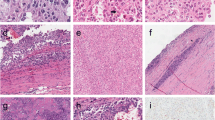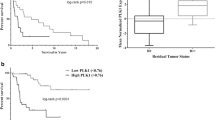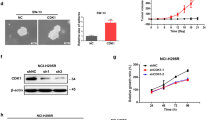Abstract
The p53 tumor suppressor requires tetramerization to function as an initiator of cell cycle arrest and/or apoptosis. Children in southern Brazil that exhibit an elevated incidence of adrenocortical carcinoma (ACC) harbor an Arg 337 to His mutation within the tetramerization domain of p53 (p53-R337H; 35 of 36 patients). The mutant tetramerization domain (p53tet-R337H) adopts a native-like fold but is less stable than the wild type domain (p53tet-wt). Furthermore, the stability of p53tet-R337H is highly sensitive to pH in the physiological range; this sensitivity correlates with the protonation state of the mutated His 337. These results demonstrate a pH-sensitive molecular defect of p53 (R337H), suggesting that pH-dependent p53 dysfunction is the molecular basis for these cases of ACC in Brazilian children.




Similar content being viewed by others
References
Prives, C. & Hall, P.A. J. Pathol. 187, 112–126 (1999).
Levine, A.J. Cell 88, 323–331 (1997).
Hollstein, M., Sidransky, D., Vogelstein, B. & Harris, C.C. Science 253, 49–53 (1991).
Pavletich, N.P., Chambers, K.A. & Pabo, C.O. Genes Dev. 7, 2556–2564 (1993).
Stürzbecher, H.W. et al. Oncogene 7, 1513–1523 (1992).
Varley, J.M. et al. Oncogene 12, 2437–2442 (1996).
Lomax, M.E. et al. Oncogene 14, 1869–1874 (1997).
Davison, T.S., Yin, P., Nie, E., Kay, C. & Arrowsmith, C.H. Oncogene 17, 651–656 (1998).
Ribeiro, R.C. et al. Proc. Natl. Acad. Sci. USA 98, 9330–9335 (2001).
Lee, W. et al. Nature Struct. Biol. 1, 877–890 (1994).
Clore, G.M. et al. Nature Struct. Biol. 2, 321–333 (1995).
Jeffrey, P.D., Gorina, S. & Pavletich, N.P. Science 267, 1498–1502 (1995).
Mateu, M.G. & Fersht, A.R. EMBO J. 17, 2748–2758 (1998).
Lomax, M.E., Barnes, D.M., Hupp, T.R., Picksley, S.M. & Camplejohn, R.S. Oncogene 17, 643–649 (1998).
Pervushin, K., Riek, R., Wider, G. & Wuthrich, K. Proc. Natl. Acad. Sci. USA 94, 12366–12371 (1997).
Mathews, C.K. & van Holde, K.E. Biochemistry (Benjanim Cummings Publishing Co., New York; 1996).
Creighton, T.E. Proteins: structures and molecular properties (Freeman & Co., New York; 1993).
Cavanagh, J., Fairbrother, W.J., Palmer, A.G. III & Skelton, N.J. Protein NMR spectroscopy (Academic Press, New York; 1996).
Chao C., Saito S., Anderson C.W., Appella, E. & Xu, Y. Proc. Natl. Acad. Sci. USA 97, 11936–11941 (2000).
Mesiano, S. & Jaffe, R.B. Endocr. Rev. 18, 378–403 (1997).
Jaffe, R.B. et al. Endocr. Res. 24, 919–926 (1998).
Spencer, S.J., Mesiano, S., Lee, J.Y. & Jaffe, R.B. J. Clin. Endocrinol. Metab. 84, 1110–1115 (1999).
Dai, H.Y., Tsao, N., Leung, W.C. & Lei, H.Y. Radiat. Res. 150, 183–189 (1998).
Neidhardt, F.C., Bloch, P.L. & Smith, D.F. J. Bacteriol. 119, 736–747 (1974).
Weigelt, J. J. Am. Chem. Soc. 120, 10778–10779 (1998).
Acknowledgements
The authors would like to thank C. Arrowsmith for providing a plasmid containing the wild type p53tet DNA sequence, and members of the Molecular Oncogenesis Program at St. Jude and the Kriwacki and Zambetti laboratories for stimulating discussion. This work was supported by the American Lebanese Syrian Associated Charities, the American Cancer Society, the NCI and a Cancer Center (CORE) Support Grant.
Author information
Authors and Affiliations
Corresponding author
Rights and permissions
About this article
Cite this article
DiGiammarino, E., Lee, A., Cadwell, C. et al. A novel mechanism of tumorigenesis involving pH-dependent destabilization of a mutant p53 tetramer. Nat Struct Mol Biol 9, 12–16 (2002). https://doi.org/10.1038/nsb730
Received:
Accepted:
Published:
Issue Date:
DOI: https://doi.org/10.1038/nsb730
- Springer Nature America, Inc.
This article is cited by
-
Predicting Peptide Oligomeric State Through Chemical Artificial Intelligence
International Journal of Peptide Research and Therapeutics (2021)
-
Frequency of the TP53 R337H variant in sporadic breast cancer and its impact on genomic instability
Scientific Reports (2020)
-
Frequency of the TP53 p.R337H mutation in a Brazilian cohort of pediatric patients with solid tumors
Molecular Biology Reports (2020)
-
Therapeutic targeting of p53: all mutants are equal, but some mutants are more equal than others
Nature Reviews Clinical Oncology (2018)
-
p53 signaling pathway polymorphisms, cancer risk and tumor phenotype in TP53 R337H mutation carriers
Familial Cancer (2018)





